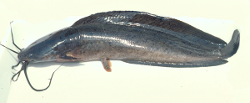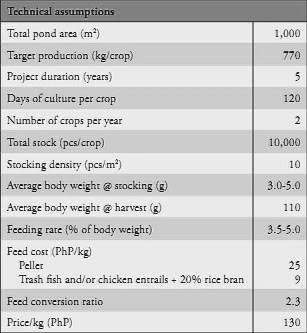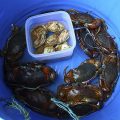Catfish is locally known as hito to Tagalogs, paltat to Ilocanos, pantat to Cebuanos and Ilonggos, and ito to Pampangeños. It is one of the most important freshwater food fishes not only in the Philippines, but in the whole of Southeast Asia. Catfish culture requires less area, can tolerate poor water quality, as well as high density stocking. In addition, disease occurrence in catfish has not been a significant problem so far.
Asian Catfish Grow-out Production

TECHNOLOGY PROFILE
Culture in ponds is the most popular and common practice in rearing catfish. Pond area ranges from 50-3,000 m2 with a depth of about 0.7-2.0 m. The inner side of dikes must be firm to prevent catfish from burrowing through and escaping. Farmed catfish can reach the market size of 80-200 g in 3-5 months from an initial stocking size of 3-5 g at 10 fingerlings/m2.
SITE SELECTION FOR PONDS
• water supply must be sufficient and clean
• area should have protection against ? flood
• free from agricultural, industrial, and domestic pollution
• soil type must be clay, sandy-clay, or clay-loam
• preferred soil pH is 6.5-7.5
• near hatchery or nursery for sufficient supply of fingerlings
• accessible
• pond area ranges from 50-3,000 m2 with a depth of 0.7-2.0 m
CULTURE TECHNIQUES
Grow-out in ponds
1. Drain, level, and dry pond bottom for 2-3 weeks. Repair gates and screens. Check dike for leaks and seepages. Eradicate unwanted species using lime. Install a fence 20-30 cm high along the perimeter dike. Apply lime at 500-1,000 kg per hectare. Apply cow dung or chicken manure at 500-1,000 kg per hectare. Let in water at an initial depth of 10-20 cm and allow to settle for 7 days. Apply inorganic fertilizer 16-20-0 at 50 kg/ha and urea at 25 kg/ha. Increase water depth to 50-60 cm.
2. Select healthy and uniform-sized fingerlings with average body weight of 3-5 grams. Acclimate fingerlings before stocking. Stock fingerlings at 5-20 pcs/m2.
3. Give catfish feeds twice daily at 5% of the total biomass for the first month, decreasing by 0.5% every month until the fifth month of culture. Trash fish, chicken entrails mixed with rice bran, kitchen refuse or stale bread may also be given to catfish.
4. Follow the usual pond routine of stock sampling, water monitoring, survival monitoring & observing for signs of disease or abnormality, and farm records keeping.
5. Prior to harvest, cook some catfish samples to detect off -? flavor. If detected, delay the harvest and determine the cause. Replenish 60-80% of pond water for 2-3 days. Hold harvested fish in tanks with running water for a few days.
6. Harvest fish when they reach 80-200 grams after 3-5 months of culture. Catfish are marketed live.
Financial Indicators


*Trash fish and/or chicken entrails + rice bran (20%)
**Pellet (50%) and trash fish and/or chicken entrails + rice bran (50%)
Source: Southeast Asian Fisheries Development Center
AQUACULTURE DEPARTMENT
www.seafdec.org.ph
© SEAFDEC/AQD 2009







tanks more info
can i grow/produce catfish in cement pond?kindly give me info/advices pls….thanks
Yes according to PhilAquaculturist (http://philaquaculture.blogspot.com/2010/06/culture-of-native-hito-clarias.html)
5 sqm concrete ponds would be enough to start an intensive culture of catfish. Just make sure do enough water changes before stocking to neutralize the cement.